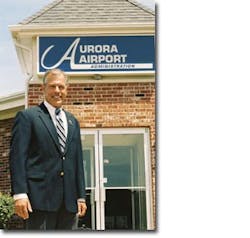AURORA, IL — Robert A. Rieser, A.A.E., P.E., manager of the Aurora Municipal Airport here, likes to say, “This airport works.” He’s also emphatic when he states, “We want to make this a business airport, but we’re not going to exclude the recreational small guy while we’re doing it.” [He owns a 1957 Cessna 182.] Developments over the past decade show that the city’s plan for the airport is working, evidenced by the influx of corporate aircraft, new business aviation tenants, a second ILS, and construction of a grass strip that will ensure the airport has in place room for growth with this, its fourth runway. Recent coups for Rieser include the addition of J.A. Air Center, which is moving from nearby DuPage Airport, and the planned addition of the Midwest sales offices for HondaJet and PiperJet, operated by Chicago Piper, an outlet of Des Moines Flying Service.
Recalls Rieser, “When I first started working out here, if we had one jet a month land, everyone stopped to watch. Now, nobody notices.”
Aurora Municipal today has some 310 based aircraft — a number that hasn’t changed dramatically. What has changed is the mix, with some 50 business jets calling Aurora home. The airport pumps some 1.4 million gallons of fuel per year; avgas accounts for 300,000.
Central to the change in business climate has been the investment in infrastructure. Since 1998, the airport has secured some $34.5 million in state and federal grants. A large part of that was spent on two new runways, a complete rehab of the primary runway, associated taxiways, and a second instrument landing system.
Growth is predictable with Chicagoland encroaching; the airport is already a designated reliever to O’Hare International and is located in the Illinois Research and Development Corridor. Aurora is also the state’s second largest city, albeit a slow-growth city for many years. The city has worked hard at economic development, and the airport has been seen as a prominent tool.
Says Rieser, “The business plan that we’ve used and the capital improvement plan that we’ve employed for many years has been focused on creating an environment that will allow businesses and corporate users to access the area. Caterpillar’s a huge user of this place, with a big plant nearby — Menard’s, Nordstrom’s. Cat brings in prospective buyers of their heavy equipment; and they bring them in Gulfstreams and other aircraft. Cat has said that they have over 50 percent success ratio when they bring people in to look at how the equipment is being built.”
The new players
In an era when the world of aviation looks with a keen eye on the introduction of the very light jets, Aurora Municipal is in a good place. It isn’t Eclipse, but it’s on par — the airport will host the Midwest sales and distribution center for both the new HondaJet and Piperjet. The two have a sales/distribution agreement that will put them side-by-side at regions across the U.S.
Chicago Piper is the selected Midwest outlet, and HondaJet has signed a letter of intent to locate here. Chicago Piper is a division of Des Moines Flying Service — a legendary name in the central U.S. because of founder Howard ‘Greg’ Gregory and his long-time number two, John Lowe.
Rieser points out that Des Moines Flying Service is the second largest wholesale Piper parts dealer in the country, and Chicago Piper has a history with Aurora.
HondaJet and PiperJet will build separate facilities, with comparable $6 million investments. “They will not allow commingling in the same hangar,” explains Rieser. “It will be two separate facilities. They [HondaJet] expect to make eight deliveries out of this facility in the third quarter 2010; they want to be open in 2009.
“The Aurora Airport just went international; not a port of entry, but having an internationally known company adds a lot to the perception of the airport and its importance to the community.”
The addition of J.A. Air Center is a comparable achievement, says Rieser. Case in point: bringing the new FBO and prominent avionics firm into the fold is projected to double the airport’s income, currently at some $900,000 a year.
The facility alone is projected to add $53.6 million in “economic output” to the airport, it tells FAA. The FBO will invest $10 million in its 107,000-square foot office/hangar complex, projected to open in 2008.
“They are bringing their complete corporate structure, including Planemasters [Part 135 operator],” says Rieser. “That’s also in our minimum standards — you have to have a charter certificate [to be an FBO]. And, their mail order business, GPS World Supply, along with some 80 employees total.”
J.A. Air Center will also operate a flight training operation with a minimum of eight trainers [again, minimum standards], which Rieser says the FBO has already acquired, and will sell fuel. It is the second refueler, with long-time FBO Luminair the incumbent.
Rieser says it was the economic impact of J.A. Air Center that led to approving a second FBO — that and they were willing to meet the minimum standards. “I looked at those numbers very carefully, to show going from one FBO to two was justifiable,” he asserts.
While the airport has a history of promoting private investment, it is willing to buy infrastructure. For J.A. Air Center, the airport is spending some $10 million on associated ramp, road, and parking lot. Says Rieser, “The city chose to stay out of the airport business and let the private sector do what they can. We don’t pump fuel; we don’t get into the private sector business.” It’s a city philosophy, he says.
In that vein, the city recently invested in laying out a fourth runway, a grass strip. It serves lighter GA in the short term, says Rieser, while getting the community adapted to the long-term footprint of the airport. “By putting it in now in turf for half a million dollars,” explains Rieser, “versus $10 million to do the paving, the taxiway, and getting federal money, we will now have it there and established.”





